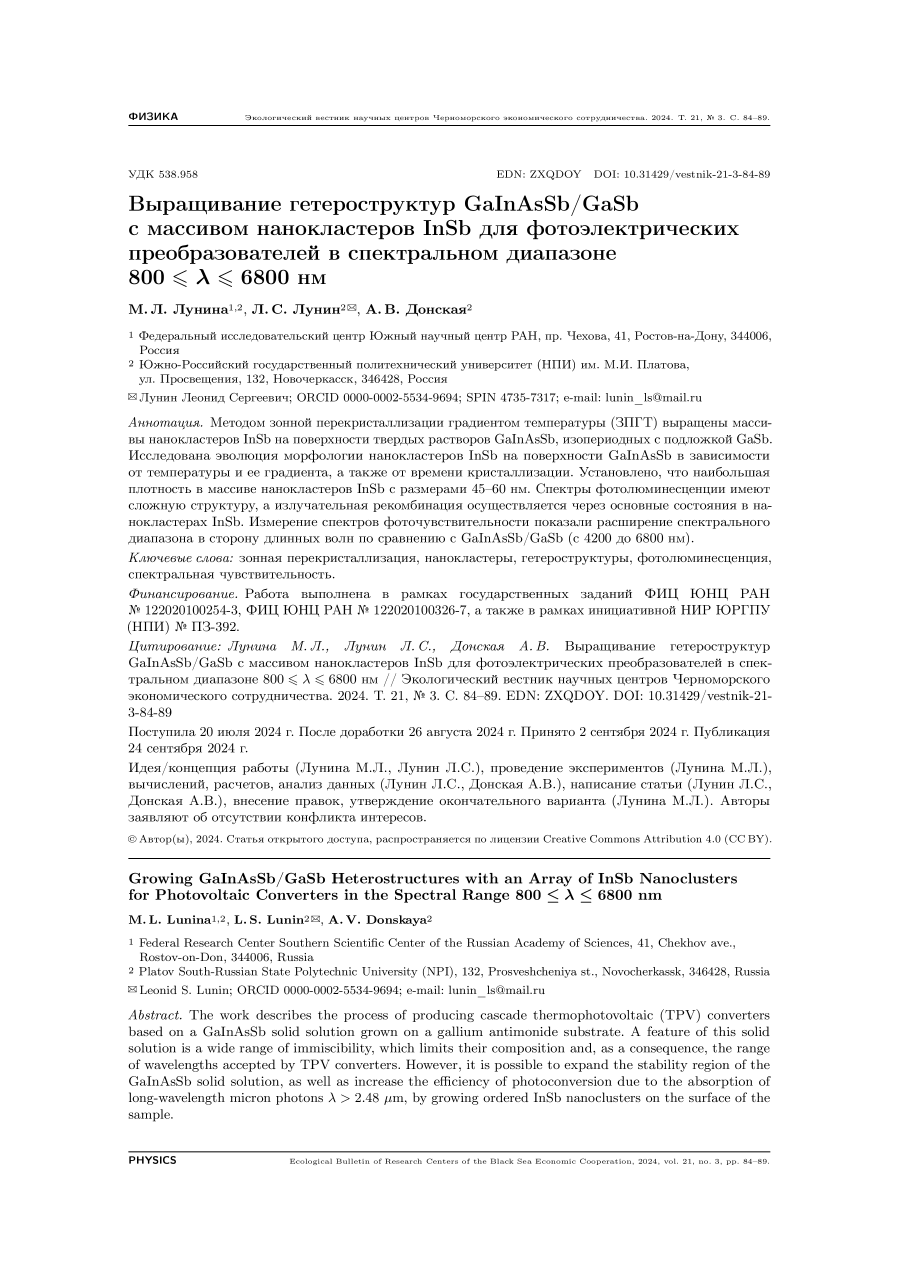Growing GaInAsSb/GaSb heterostructures with an array of InSb nanoclusters for photovoltaic converters in the spectral range 800 ≤ λ ≤ 6800 nm
UDC
538.958DOI:
https://doi.org/10.31429/vestnik-21-3-84-89Abstract
The work describes the process of producing cascade thermophotovoltaic (TPV) converters based on a GaInAsSb solid solution grown on a gallium antimonide substrate. A feature of this solid solution is a wide range of immiscibility, which limits their composition and, as a consequence, the range of wavelengths accepted by TPV converters. However, it is possible to expand the stability region of the GaInAsSb solid solution, as well as increase the efficiency of photoconversion due to the absorption of long-wavelength micron photons λ >2.48 μm, by growing ordered InSb nanoclusters on the surface of the sample. As a result of the study, it was noticed that the surface morphology depends on the deposition time of the InSb growth material. The height of nanoclusters is influenced by the crystallization time, the temperature of the growth process and the temperature gradient. Thus, the height of nanoclusters increases linearly with crystallization time and temperature gradient, and increases exponentially with increasing temperature. Thus, the optimal deposition time is 8 minutes. In addition, the photoluminescence spectrum of the Ga0.90In0.10As0.15Sb0.85/GaSb heterostructure was obtained. It shows two peaks caused by radiative recombination in the GaInAsSb layer and InSb nanoclusters. The spectral dependence of the photosensitivity of the heterosystem shows that the wavelength range is in the range 800–6800 nm.
Keywords:
zone recrystallization, nanoclusters, heterostructures, photoluminescence, spectral sensitivityAcknowledgement
References
- Timothy, J.C., An overview of thermophotovoltaic generation electricity. Solar Energy Materials & Solar Cells, 2001, vol. 66, pp. 443–452. DOI: 10.1016/S0927-0248(00)00206-3
- Andreev, V.M., Khvostikov, V.P., Larionov, V.R., Rumyantsev, V.D., Sorokina, S.V., Shvarts, M.Z., Vasil'ev, V.I., Vlasov, A.S., Tandem GaSb/InGaAsSb thermophotovoltaic cells. Conf. Record of the IEEE Photovoltaic Specialists Conference. Proc. of the 1997 IEEE 26th Photovoltaic Specialists Conference, 1997, pp. 935–938.
- Mauk, M.G., Shellenbarger, Z.A., Cox, J.A., Sulima, O., Bett, A.W., Mueller, R.L., Sims, P., McNeely, J.B., DiNetta, L.C., Liquid-phase epitaxy of low-bandgap III-V antimonides for thermophotovoltaic devices. Journal of Crystal Growth, 2000, vol. 211, no. 1–4, pp. 189–193. DOI: 10.1016/S0022-0248(99)00796-4
- Левин, Р.В., Власов, А.С., Зотова, Н.В., Матвеев, Б.А., Пушный, Б.П., Андреев, В.М., Свойства эпитаксиальных слоев антимонида галлия, полученных методом газофазной эпитаксии из металлорганических соединений. Физика и техника полупроводников, 2006, т. 40, № 12, c. 1427–1431. [Levin, R.V., Vlasov, A.S., Zotova, N.V., Matveev, B.A., Pushnyi, B.P., Andreev, V.M., Properties of gallium antimonide epitaxial layers grown by MOCVD method. Fizika i tekhnika poluprovodnikov = Semiconductors, 2006, vol. 40, iss. 12, pp. 1427–1431. (in Russian)]
- Danilina, E.M., Paschenko, A.S., Estimation of thermodynamic stability of isoperiodic epitaxial structures with GaInSbAs and GaInAsP solid solution. Journal of Physics Conference Series, 2021, vol. 2086, no. 1, p. 012004. DOI: 10.1088/1742-6596/2086/1/012004
- Tien, D.N., Kim, J.O., Lee, S.J., Growth of InGaAsSb/GaSb compound for infrared optoelectronic devices. Condensed Matter and Interphases, 2022, vol. 24, no. 2, pp. 250–255.DOI: 10.17308/kcmf.2022.24/9265
- Лунина, М.Л., Алфимова, Д.Л., Лунин, Л.С., Пащенко, А.С., Чеботарев, С.Н., Тонкослойные гетероструктуры GaInSbAsPBi/GaSb, полученные из жидкой фазы в поле температурного градиента. Кристаллография, 2017, т. 62, № 1, с. 137–142. [Lunina, M.L., Alfimova, D.L., Lunin, L.S., Pashchenko, A.S., Chebotarev, S.N., Thin-layer GaInSbAsPBi/GaSb heterostructures obtained from the liquid phase in a temperature gradient field. Kristallografiya = Crystallography Reports, 2017, vol. 62, no. 1, pp. 137–142. (in Russian)] DOI: 10.7868/S0023476117010040
- Liu, L., Liu, Yg., Zhang, Xm., Liu, B., Zhang, X., Low phase noise and quasi-tunable millimeter-wave generator using a passively InAs/InP mode-locked quantum dot laser. Optoelectronics Letters, 2020, vol. 16, no. 6, pp. 441–445. DOI: 10.1007/s11801-020-0016-z
- Bimberg, D., Grundmann, M., Ledentsov, N.N., Quantum dot heterostructures. England, John Wiley & Sons, 1999.
Downloads
Submitted
Published
How to Cite
Copyright (c) 2024 Lunina M.L., Lunin L.S., Donskaya A.V.

This work is licensed under a Creative Commons Attribution 4.0 International License.




